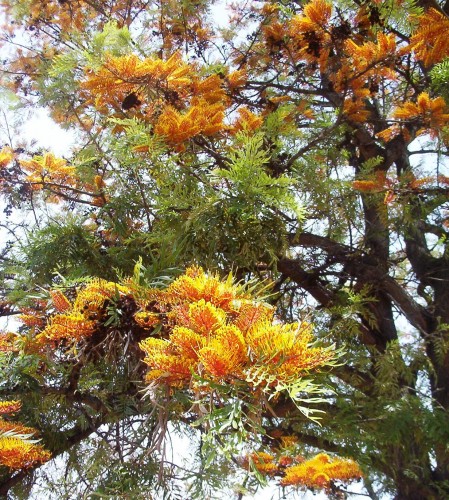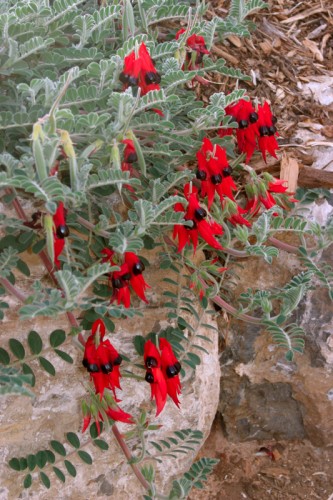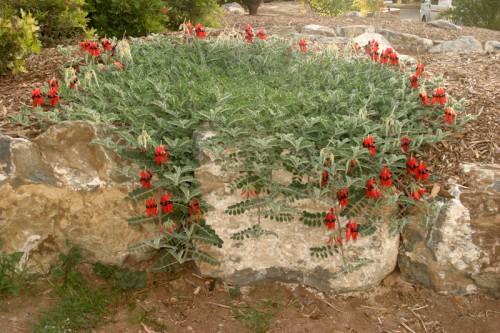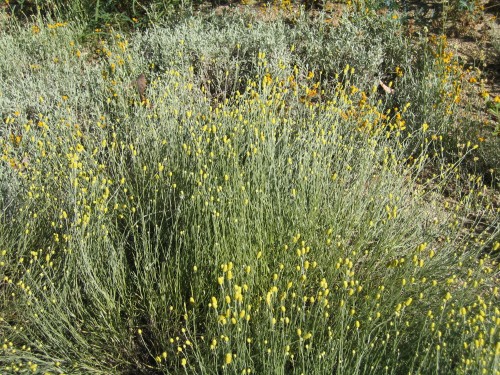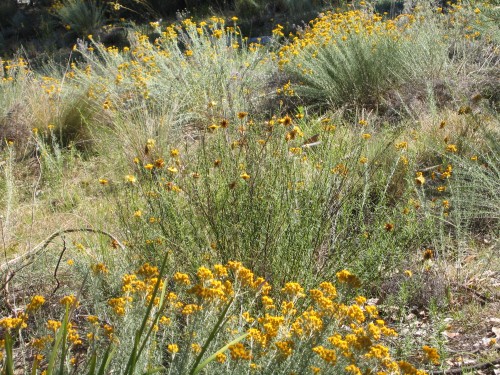Australian plants growing overseas.
I had the opportunity to travel to Ethiopia, and what should greet me on leaving the airport but a stand of Grevillea robusta (Silky Oak), Acacia mearnsii (Black Wattle), a Melaleuca I didn’t recognize and a Eucalyptus species. (Who would have thought I would need Ivan Holliday’s book on Melaleucas in an overseas country?) Having seen these, my eyes picked them out constantly during our stay. There were forests of Eucalypts, attempts to keep Eucalypts going as street trees, and I noticed in some local nurseries, advanced plants of Eucalypts, Acacia and Grevillea robusta. In the grounds of the place where we stayed were Callistemon (Bottlebrush) species which looked like forms of Callistemon viminalis.
It was a difficult exercise to determine what plants were the naturally occurring species in the country side of Ethiopia. There had been much clearing of vegetation, and because the naturally occurring plants were much slower growing, they were not replaced. The need for wood for fuel and building supplies compromised the revegetation programmes.
Over the years many Australian species have been propagated in foreign nurseries and proved to be popular garden and pot plants for gardeners interested in the foliage and many unusual flower forms.
Swainsona formosa (Sturt’s Desert Pea)
I was sent some lovely photos of Sturt’s Desert Pea by a reader of this blog. As you can see, the plant is dense and lush, as you would want to have it in the garden, not in a state of survival.
Sturt Peas need to be watered. They respond with excellent growth and numerous flowers. Water well pots are very good.
The only exception to this might be if you had a self sown plant. These are remarkably hardy as self sown plants seem to send the roots very deep.
They also respond to being fed. Use a fertiliser designed for native plants.
In the photos the plant is growing in a raised bed. It has been shown that so long as the planting mound is at least 10cm(4 inches) above the surrounding soil, that will give the required good drainage.
Eremophilas (Emu Bush) in Medicine
The following is an extract from an article on the ABC Website concerning the research that has been going on with Eremophilas. These are hardy plants, with attractive flowers which are loved by Honeyeaters.
More on Eremophilas can be seen here. Also see the category Eremophilas.
Australian native plants are being used to develop new antibacterial agents for coating biomedical implants (Source: Hans Griesser)
An extract from a flowering desert plant, used as traditional medicine by Indigenous Australians, could one day be used to coat hip transplants and other biomedical devices, say researchers.
Professor Hans Griesser and colleagues are presenting their work this week at a biomaterials conference at the University of New South Wales in Sydney.
“We can learn so much from nature and traditional knowledge,” says Griesser, a materials scientist from the University of South Australia.
He says Aboriginal people use leaves of Eremophila plants, which grow in Australia’s desert areas, to make ointments for skin abrasions and gargles for throat infections.
More of the article can be read here.
Calocephalus citreus (Lemon Beauty-heads)
Calocephalus citreus is a small member of the daisy family, growing 20-50 cm high by 30-60 cm wide. It has silver grey foliage and small, yellow button type flowerheads in late Spring to Summer. The photo was taken in early January at Canberra Botanic Gardens.
This plant is perennial and should be pruned after flowering when new growths begin near the base of the plant. It is hardy in most situations and withstands dry periods.
I would call it a drought tolerant plant when I observe its survival here. It grows in loam and sand, in half to full sun, including dappled sun.
This attractive daisy dries well for use in flower arrangements.
Daisies in Cottage Gardens
A cottage garden is the ideal garden for many of the Australian native daisies. Chrysocephalum semipapposum (Clustered Everlasting) was growing in Canberra Botanic Gardens in a wild bush gardens which could have been turned into a cottage garden with its random planting arrangements.
The photo shows the ‘natural’ looking effect that can be achieved by planting several plants of a species in an irregular grouping, with other plants of different form, leaf and flower colour, and height.
